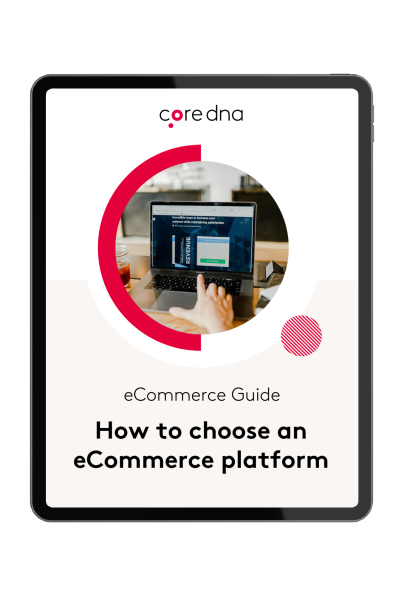When to consider Single Page Applications?
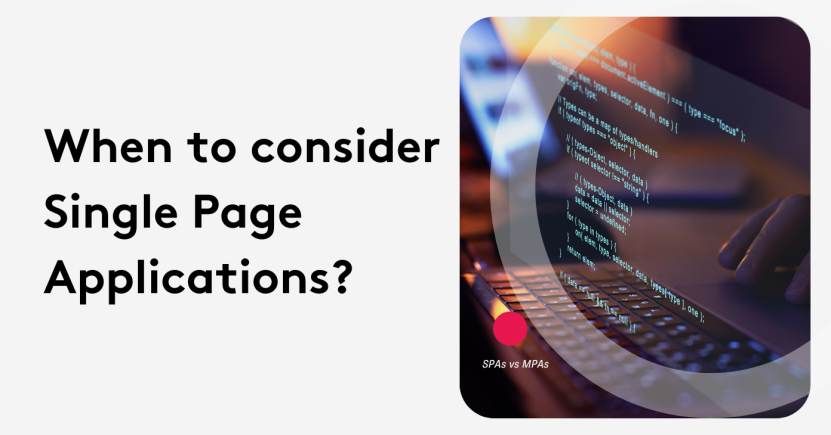
Single-page applications (SPAs) have revolutionized dynamic content and continuous "user experiences." They give brands the possibility to update results and content for the user without the need to refresh any page. The best example that comes to mind is scrolling through social media.
The way we interact with Instagram or TikTok is powered by SPAs: continuous content appears without any refresh. In this article, we will attempt to explain SPAs in details and show you when and how to use them.
On this page:
Single Page Applications: Explained
Honestly, the best way to describe SPA or single-page application is by diving into examples and you will understand why.
If we were to give you the technical explanation of an SPA, you will get something like this: a web application that loads one HTML page and dynamically updates the content while the user is on the page without requiring a reload or a new page.
Can you tell me what an SPAs is based on that? probably still confusing....
If we told you Gmail, Netflix, Slack, Instagram are all SPAs ... now you get it! The fact that you can receive notifications without having to refresh any page is what makes SPAs so unique and an incredible technology!
On the opposite spectrum, Multi Page Applications (MPA), refer to the usual content websites where a new page loads as the user interacts with it.
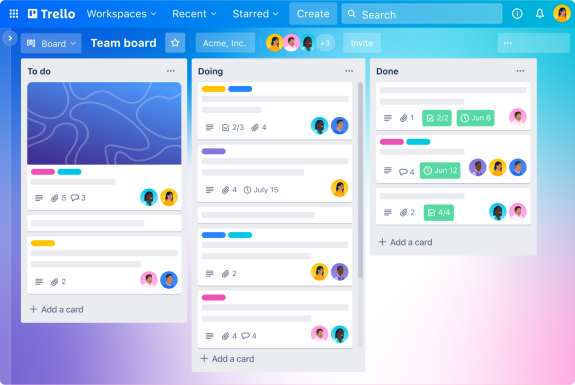
The Inception of Single Page Applications
The Single page applications are the innovation developers brought to this world to create better user experience, faster loading time, and bring to life instant results.
SPAs are a substantial upgrade from early server-driven websites, where every interaction required additional page rendering while data was pulled from servers. We moved from having to press page 2 to see new content to simply having to scroll.
JavaScript frameworks like Vue.js, Angular and React are what make SPAs possible. JavaScript frameworks enable applications to act similarly to computer software, offering the same level of responsiveness and interaction.
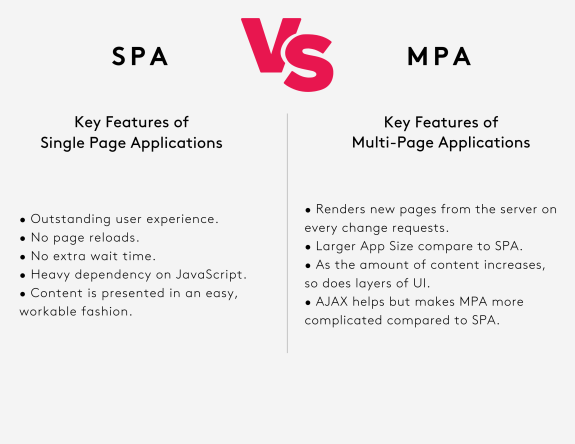
Single-Page Applications vs Multi-Page Applications
Let's take a look at the difference between Single-Page Applications (SPAs) and Multi-Page Applications (MPAs).
Single-Page Applications (SPAs) are the perfect choice for applications that require instant results and continuous updates. As we talked about previously, social media scrolling is a prime example, or online exam results, streaming services and even productivity platforms such as Monday.com or Trello.
If we take Trello as an example, it uses an SPA architecture to allow users to drag and drop cards, edit tasks, and update information in real-time without needing to reload the page. By going the SPA route, Trello makes sure its users get a seamless, dynamic experience drag and dropping items and following project progress.
SPAs excel in these types of interactive environments, where state management and reactivity are key.
However, SPAs can be slow-loading since the JavaScript framework must be downloaded and executed before the content is rendered. Search engines may also struggle to index dynamically loaded content, even with advancements like server-side rendering (SSR), which could hurt your SEO.
Multi-Page Applications (MPAs) or more traditional “wesbite builders” are better suited for content-rich websites that needs SEO to be performing well. A real-life example is The New York Times website. With all the content spread across numerous categories, each page in the MPA loads separately, which helps search engines crawl and index the content efficiently.
For websites like the NYT, where content discovery through search engines is critical, MPAs offer better SEO optimization, as each page has its own unique URL, metadata, and faster individual load times compared to SPAs.
MPAs may not provide the same seamless transitions between pages as SPAs, but they avoid the performance bottlenecks of heavy JavaScript frameworks, making them more efficient for larger, content-driven sites.
So When do you use SPAs and MPAs
- SPA: Ideal for highly interactive applications with dynamic content, such as dashboards (e.g., Trello), real-time collaboration tools, or social media platforms (e.g., Facebook).
- MPA: Best for large, SEO-focused websites with extensive content and independent pages, such as news sites (e.g., The New York Times), blogs, or eCommerce platforms with many product pages.
If you are looking for interactive, user-driven experiences that need instant updates and real-time data then SPAs are your friend. On the other hand,. MPAs will be more appropriate if you are building SEO and content-heavy websites where each page needs to be independently optimised for search engines.
How are Single-Page Applications architectured?
Client-Side Rendering
What makes SPAs so unique is the client-side rendering. What this means is that the browser is responsible for handling all user interactions. Once the page is loaded, JavaScript runs to manage the app, updating the content and exchanging information with the backend. That’s the main reason why SPAs can deliver fast interactions.
JavaScript Frameworks are the backbone of the structure and provide the tools to manage everything from data binding to component management and routing. These are the most crucial frameworks.
React
React is the popular library that Meta developed. It helps build SPAs by providing reusable UI components. It’s perfect for dynamic content updates as it handles the view layer with a virtual DOM (Document Object Model). A virtual DOM is a memory-based copy of a web page's real DOM elements, allowing for improved performance and speed.
Angular
Angular is a complete framework for building SPAs developed by Google. It provides tools for HTTP requests, two-way data binding, and routing, making it an excellent option for more complex SPAs.
Vue.js
Vue.js is known for being straightforward and lightweight, but it’s still popular for small—and large-scale SPAs due to its ease of integration and incremental adoption. Developers love it because it’s easy to learn and deploy. You can use Vue for a small part of a project or scale it to build full SPAs.
Server-Side Communication
SPAs request data from servers in JSON format, typically with REST or GraphQL APIs. While the server delivers the data, the application logic is still on the client side. This reduces the server load and contributes to scalability. Running more processes on the server side will result in increased latency, which could translate to poor website performance. SPAs have an edge here with client-side communication.
Key Features of Single-Page Applications
SPAs offer fast dynamic content loading. It downloads only the essential data from the server and continually refreshes specific parts of the page. This feature is what allows endless scrolling, which enhances user experience and navigation.
SPAs can also be configured to offer offline functionality with caching mechanisms. After the initial load, it can work with locally cached data.
When it comes to performance, althougth the initial load time is slow, SPAs perform exceptionally well after that. Once the JavaScript resources have been loaded, the following interactions only require small data fetches, which keeps the performance quick.
Benefits Of Single Page Applications
SPAs have introduced to the world a faster, smoother user experience. They gave us instant results, limited user interaction and less patience! This is possible because SPAs only require one initial load. Users can then switch between different parts of the application without reloading. Additionally, SPAs mimic the interactivity and responsiveness of apps to increase engagement, leading to an app-like feel in the browser.
They also score better in the performance area as after the initial page load thanks to client-side rendering.
Web development can be complex, but JavaScript frameworks allow for modular code, which makes the process simpler and more efficient.
When are Single Page Applications a better choice?
If you are looking to provide a consistent omnichannel experience, then SPAs are a good choice as they provide the same experience across different devices due to client-side rendering. This is especially useful in mobile environments where high performance is required.
They also require less data - in most cases -, which is excellent for mobile users. Once the initial page load is completed, additional data usage isn’t required.
Since the webpage won’t have to reload with every interaction, SPAs offer a smooth, sleek user experience which is impossible to beat.
Popular Examples of Single Page Applications
From Saas to social media, SPAs can be found everywhere you look - well if where you look need to have real-time communication and continuous results without interruption. Here are a few examples.
- Productivity Suites: Online Applications like Microsoft 365 and Google Docs are great examples of SPAs that are used on a daily basis. Users can collaborate on documents and manage real-time communication.
- Social Media: Social media sites like Facebook, X (Formerly Twitter) and Reddit place a distinctive focus on real-time updates and communication. This is achieved with the help of SPAs, and is probably a major factor in why the biggest JavaScript Frameworks were created by Meta, Google etc.
- Music and Entertainment: Entertainment services like Spotify, Apple Music and Netflix rely on SPAs to offer an uninterrupted media experience.
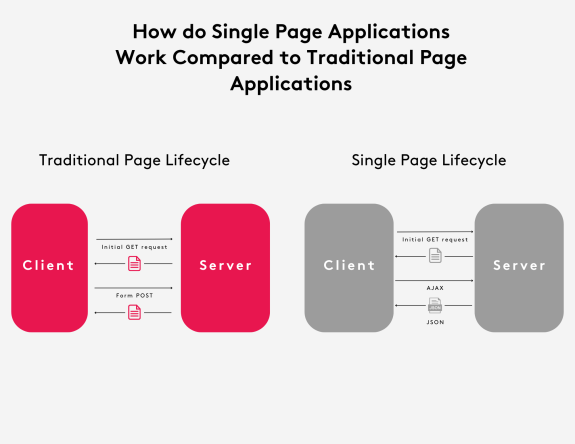
Challenges and Considerations for Single Page Applications
While SPAs are overall faster, the initial load time can be high. This is because the entire application’s JavaScript must be loaded before any interaction occurs.
When I comes to SEO, it is said that search engines can’t effectively crawl dynamic content. This means that if you rely on SEO for traffic than you can negatively affect your website if you implement SPAs. A little bird told us that things are changing... let's wait and see.
Another point is security. Since most of the application’s logic is handled client-side, SPAs are more vulnerable to some attacks, primarily Cross-Site Scripting (XSS) attacks. Security measures must be carefully planned and implemented to guard any vulnerable spots.
When to Choose a Single-Page Application
Interactive Platforms: SPAs are great for platforms that include dashboards, social networking or real-time updates.
Mobile Applications: SPAs are great for mobile-friendly websites due to their consistency across different devices.
Efficiency: SPAs are ideal for creating visually appealing web pages that are efficient and convenient. Users don’t have to reload every time they interact with the page.
What is the process of building Single-Page Applications
3 drivers will always guide the development process of SPAs: JavaScript Frameworks, Client-side rendering, and overseeing API-Driven communication.
Let's start with JavaScript Frameworks
The most popular frameworks are without a doubt, Angular, React and Vue, but the landscape is expanding with new players like Svelte are gaining ground. These are web frameworks that will provide developers with a set of tools and libraries to avoid repetitive coding. To begin, developers use CLI tools like Create React and Angular CLI to set up the project structure, install dependencies, and set up a local server.
Component-based Architecture
The component-based architecture is a "make life easy hack". Basically instead of creating general templates, Developers will create independent components and then use the components to mix and match and build templates. Forms, data tables, buttons, simple text, each one will be separate components that can be puzzled together to form a template. This is a very scalable approach as you can build indefinite numbers of templates and each component is stateless which ensures that the app is maintainable, scalable and modular.
Client-side Rendering
SPAs reliy on client-side rendering to allow the browser to dynamically update the user interface without reloading the entire page. The javascript Frameworks are the ones managing these updates smoothly, usually relying on a virtual DOM to minimize performance issues and increase responsiveness.
API-Driven Development
Most of the data handled within the SPAs is done via API. Apis allow for smooth communication with the server via GraphQL or a similar program. Data is sent and received in synch, which allows the content within the SPAs to be updated without the page reloading.
State Management
For a more complicated SPA, managing the state in different components requires careful planning. Libraries like Vuex (Vue.js) and NgRx (Angular) are popular for state management. They guarantee data consistency in the app and reduce bugs and other vulnerabilities.
Performance Optimization
When building SPAs it is always good to keep in mind how to optimize network requests so improve performance. Developers can use techniques like debouncing and throttling to reduce the frequency of API calls for optimization. Caching frequently used data is also a great strategy to maintain performance. React queries and SWR provide some caching capabilities out of the box. These practices reduce issues like initial load time delays and improve the user-experience.
How are Single Page Applications reshaping web development
SPAs allow us to bring an app-like user experience with faster, more interactive web pages that are seamless regardless of the device they are being viewed on. While there are some challenges concerning SEO optimization and initial loading times, the benefits are too significant to pass up, especially when it comes to collaborative and social, apps.
As SPAs advance and evolve, new techniques are emerging to improve performance and user experience. These trends include new caching methods and integration with progressive web apps (PWAs), bringing leaps in data visualization, image processing, and rendering.
We are looking forward to what SPAs will bring to user experience and how developers will keep finding ways to improve the way we interact online.

